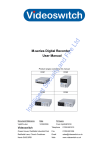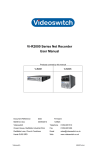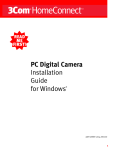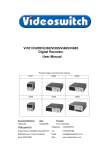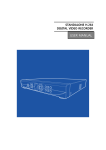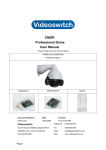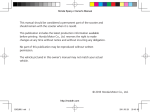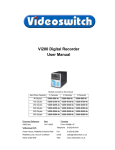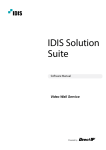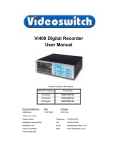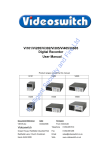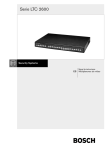Download User Manual - Videoswitch
Transcript
M-series Digital Recorder User Manual Product ranges covered by this manual Vi-M1 Vi-M2 Vi-M3 Vi-M4 Document Reference Date Firmware Vip601a.doc 12/05/2009 From Vip004#1818 Videoswitch Telephone 01252-851510 Ocean House, Redfields Industrial Park Fax 01252-851296 Redfields Lane, Church Crookham Email [email protected] Hants GU52 0RD Web www.videoswitch.co.uk Vip601a.doc Digital Recorder Contents: 1 Start Here ..................................................................1 1.1 Connecting Up the Vi-M1 .......................................................................................................2 1.2 Connecting Up the Vi-M2 .......................................................................................................3 1.3 Connecting up the Vi-M3 & Vi-M4..........................................................................................4 1.4 Setting Date/Time ..................................................................................................................4 1.5 Recording...............................................................................................................................5 1.6 Routine Checks......................................................................................................................5 1.7 Care of the Hard Drive(s) .......................................................................................................5 1.8 Critical Alerts ..........................................................................................................................5 2 Control.......................................................................6 2.1 Mini Keypad ...........................................................................................................................6 2.2 Standard Keypad ...................................................................................................................8 2.3 Live Viewing .........................................................................................................................11 1.1.1 1.1.2 1.1.3 2.4 Viewing Full Screen Images ............................................................................................11 1.1.1.1 Quad Display ..................................................................................................11 1.1.1.2 Multi-Screen ...................................................................................................11 Spot monitor(s) ................................................................................................................11 Tagging Images ...............................................................................................................12 Playback...............................................................................................................................13 3 Navigation ...............................................................15 3.1 Menus ..................................................................................................................................15 3.2 Mini-Keypad .........................................................................................................................15 3.3 Standard Keypad .................................................................................................................15 3.4 Summary of keys used in menus .........................................................................................16 4 Find..........................................................................18 4.1 Date/Time.............................................................................................................................18 4.2 Events ..................................................................................................................................18 1.1.4 Alarm................................................................................................................................18 1.1.5 System .............................................................................................................................18 1.1.6 Critical ..............................................................................................................................18 5 Burn .........................................................................19 5.1 Edit Incident .........................................................................................................................19 5.2 Incident List ..........................................................................................................................20 6 Menus ......................................................................21 6.1 1.1.7 1.1.8 6.2 1.1.9 1.1.10 6.3 1.1.11 Date/Time.............................................................................................................................21 System date/time .............................................................................................................21 Date format ......................................................................................................................21 Record..................................................................................................................................22 Record settings ................................................................................................................22 1.1.1.3 Mode ..............................................................................................................22 1.1.1.4 Format ............................................................................................................22 1.1.1.5 Quality ............................................................................................................23 1.1.1.6 Auto Retention................................................................................................23 1.1.1.7 Custom Rate per camera ...............................................................................23 1.1.1.8 Alarm rate per camera....................................................................................23 Record audio....................................................................................................................23 Display .................................................................................................................................23 Titles ................................................................................................................................23 1.1.1.9 i Server .............................................................................................................23 Digital Recorder 1.1.1.10 Camera Titles .................................................................................................24 1.1.1.11 Show Camera Titles .......................................................................................24 1.1.1.1.1 Full 24 1.1.1.1.2 Quad 24 1.1.1.1.3 x9 24 1.1.1.1.4 x16 24 1.1.1.12 Auto sequence (main monitor) .......................................................................24 1.1.1.1.5 Sequence Mode 24 1.1.1.1.6 Camera List 24 1.1.1.1.7 Dwell times 25 1.1.1.1.8 Dwell times (all) 25 1.1.1.13 Auto sequence (spot monitor) ........................................................................25 1.1.1.1.9 Spot1 25 1.1.1.1.10 Sequence Mode 25 1.1.1.1.11 Camera List 25 1.1.1.1.12 Dwell times 25 1.1.1.1.13 Dwell times (all) 25 1.1.1.14 Spot monitor options ......................................................................................25 1.1.1.1.14 1.1.1.15 1.1.1.1.15 6.4 1.1.12 1.1.13 1.1.14 Spot1 25 Power-up options ...........................................................................................26 Main monitor format 26 Alarms ..................................................................................................................................26 Alarm inputs .....................................................................................................................26 1.1.1.16 Alarm polarities...............................................................................................26 1.1.1.17 Camera mapping ............................................................................................26 1.1.1.18 Alarm timers ...................................................................................................26 1.1.1.19 Weekday alarm times .....................................................................................26 1.1.1.20 Weekend alarm times.....................................................................................26 1.1.1.21 Enable alarms all day .....................................................................................27 Activity..............................................................................................................................27 1.1.1.22 Activity timers .................................................................................................27 1.1.1.23 Weekday activity times ...................................................................................27 1.1.1.24 Weekend activity times...................................................................................27 1.1.1.25 Enable activity all day.....................................................................................27 Critical alerts ....................................................................................................................27 1.1.1.1.16 Videloss 27 1.1.1.1.17 Record stopped 27 1.1.1.1.18 Hard drives 27 1.1.15 Clear critical alerts ...........................................................................................................28 1.1.16 Erase event list ................................................................................................................28 1.1.17 Pull-up and restore...........................................................................................................28 1.1.18 6.5 1.1.19 1.1.20 ii 1.1.1.1.19 Pull-up monitor 1.1.1.1.20 Pull-up hold time 28 28 1.1.1.1.21 Pull-up sequence time 28 1.1.1.1.22 Relay hold time 28 1.1.1.1.23 Restore camera 28 Relay activation................................................................................................................28 1.1.1.26 Use relay1 for alarm .......................................................................................28 1.1.1.27 Use relay2 for critical alert..............................................................................29 Network ................................................................................................................................29 IP address ........................................................................................................................29 Ports.................................................................................................................................29 1.1.1.28 Command .......................................................................................................29 1.1.1.29 Video ..............................................................................................................29 Digital Recorder 1.1.21 Sub-net mask...................................................................................................................29 1.1.22 Gateway ...........................................................................................................................29 1.1.23 6.6 MTU .................................................................................................................................30 Configuration........................................................................................................................30 1.1.24 Language .........................................................................................................................30 1.1.25 Unit number .....................................................................................................................30 1.1.26 1.1.27 Display .............................................................................................................................30 1.1.1.30 VGA resolution ...............................................................................................30 1.1.1.31 VGA gamma ...................................................................................................30 1.1.1.32 VGA motion ....................................................................................................30 1.1.1.33 Menu translucency .........................................................................................30 1.1.1.34 Boundary colour .............................................................................................30 Camera inputs..................................................................................................................30 1.1.1.35 1.1.28 Termination ....................................................................................................30 Passwords .......................................................................................................................31 1.1.1.36 Logged off user ..............................................................................................31 1.1.1.1.24 1.1.1.37 1.1.1.1.25 1.1.29 Access rights 31 Named users ..................................................................................................31 User1..User4 31 Coverts.............................................................................................................................31 1.1.1.38 Covert cameras (Main) ...................................................................................31 1.1.1.39 Covert cameras (Spot1) .................................................................................31 1.1.30 Restore factory defaults ...................................................................................................31 1.1.31 Restart the system ...........................................................................................................31 7 Help..........................................................................33 7.1 Status/Config........................................................................................................................33 1.1.32 Config...............................................................................................................................33 1.1.33 Status ...............................................................................................................................33 1.1.34 Drives ...............................................................................................................................34 1.1.35 Drive1...............................................................................................................................34 1.1.36 Record .............................................................................................................................35 8 Function ..................................................................36 9 Password ................................................................37 10 Connections............................................................38 10.1 Ethernet connection to Broadband ......................................................................................38 10.2 Ethernet connection to a PC ................................................................................................38 10.3 Ethernet connection to a LAN ..............................................................................................39 10.4 Audio ....................................................................................................................................39 10.5 Multi Unit Cascading ............................................................................................................40 11 Technical Data ........................................................41 11.1 Accessories Included ...........................................................................................................41 11.2 Changing the Hard Drive .....................................................................................................41 1.1.37 Changing a hard drive - Vi-M1 .........................................................................................41 1.1.38 Changing a hard drive - Vi-M2/Vi-M3/Vi-M4 ....................................................................42 1.1.39 Alarms, Domes, Relays ...................................................................................................43 1.1.40 Main Keyboard Port .........................................................................................................44 1.1.41 11.3 Spot Keyboard/Cascade Port ..........................................................................................44 Specifications .......................................................................................................................45 1.1.42 Storage ............................................................................................................................45 1.1.43 Digital recording/Replay...................................................................................................45 1.1.44 Display .............................................................................................................................45 iii Digital Recorder 1.1.45 Control and Interface .......................................................................................................46 1.1.1.40 Dome Control .................................................................................................46 1.1.1.41 Remote Viewing .............................................................................................47 1.1.46 Power, Physical & Environmental ....................................................................................48 1.1.47 Upgrades .........................................................................................................................48 1.1.48 CE Marking ......................................................................................................................49 1.1.49 Ventilation ........................................................................................................................49 1.1.50 Safety...............................................................................................................................49 12 Warranty Fax-Back .................................................51 iv Digital Recorder 1 Start Here Please fill in the warranty fax-back form on page 51 and return it to Videoswitch • The Vi-M1, Vi-M2, Vi-M3 and Vi-M4 digital recorders from Videoswitch are part of the M-series range • These products are designed to be easy to use whilst offering high quality digital video recording and playback, primarily for CCTV security applications. • The video images from all connected cameras are continuously recorded onto the built-in hard drives. When the drives are full, the M-series keeps on recording, overwriting the oldest images. • Images are retained for a specified user programmable number of days, typically 31. All images recorded within the period will be available for replay. Older image are no longer available. • Several methods are provided for finding the recorded images you want quickly, including date/time searches and activity or alarm event searches • The built-in DVD writer allows a selected part or parts of the recorded information to be written onto a DVD or CD, typically to back-up an incident for use as evidence by the Police. • A USB interface allows incidents to be backed up to USB memory sticks as an alternative to DVD or CD • The recording process continues all the time, even when playing back or backing up incidents • Dual channel audio recording is standard on the M-series • Ethernet is also a standard feature allowing remote viewing via a local area network (LAN) or via Broadband Ethernet • Multiple Vi-M3 and Vi-M4 DVRs may be cascaded to cater for larger numbers of cameras. Build in matrix switching combines monitor outputs so that the group of DVRs can drive one (BNC) main monitor and 3 independent spot monitors. • Software updates may be installed via CD, USB memory stick or via ethernet Note: This manual covers a range of products and therefore describes features that do not exist in all models. 1 Digital Recorder 1.1 Connecting Up the Vi-M1 For a standard digital recording system you will need 2 • The Vi-M1 recorder • Some cameras with lenses • A video monitor (with BNC composite video input) or a VGA monitor • BNC cables • Connect the monitor output (M1) of the Vi-M1 to a Video Monitor using a BNC cable. Alternatively or additionally, connect a VGA monitor to the VGA output • Make sure that the monitor termination is switched on (i.e. to 75 Ohms) • On 8-camera models, a spot monitor may also be connected, to output M2 • Connect a camera to Camera Input 1 on the Vi-M1 using a BNC cable • Connect further cameras to Inputs 2,3,4 etc • Make sure that the mains supply is rated at the correct mains voltage. In UK and Europe this is normally 230Vac • Connect the mains power using the mains cable provided Digital Recorder 1.2 Connecting Up the Vi-M2 For a standard digital recording system you will need 3 • The Vi-M2 recorder • Some cameras with lenses • A video monitor (with BNC composite video input) or a VGA monitor • BNC cables • Connect the monitor output (M1) of the Vi-M2 to a Video Monitor using a BNC cable. Alternatively or additionally, connect a VGA monitor to the VGA output • Make sure that the monitor termination is switched on (i.e. to 75 Ohms) • On 8-camera models, a spot monitor may also be connected, to output M2. • Connect a camera to Camera Input 1 on the Vi-M2 using a BNC cable • Connect further cameras to Inputs 2,3,4 etc • Make sure that the voltage select switch (if present) is set to suit the mains supply. The setting required in UK and Europe is normally 230Vac • Connect the mains power using the mains cable provided Digital Recorder 1.3 Connecting up the Vi-M3 & Vi-M4 For a standard digital recording system you will need • The Vi-M3 recorder • Some cameras with lenses • A video monitor (with BNC composite video input) or a VGA monitor • BNC cables • Connect the monitor output (MAIN) of the Vi-M3 to a Video Monitor using a BNC cable. Alternatively or additionally, connect a VGA monitor to the VGA output • Make sure that the monitor termination is switched on (i.e. to 75 Ohms) • Up to 3 other spot monitors may be connected to outputs M2, M3 and M4 (or 2 spot monitor on 12-camera models) • Connect a camera to Camera Input 1 on the Vi-M3using a BNC cable • Connect further cameras to Inputs 2,3,4 etc • Make sure that the voltage select switch (if present) is set to suit the mains supply. The setting required in UK and Europe is normally 230Vac. • Connect the mains power using the mains cable provided 1.4 Setting Date/Time For proper operation of the M-series DVR Digital Recorder it is essential that the date and time are set correctly. If the system clock has an invalid date or time when the M-series DVR is powered up or at any time during operation, the displayed date and time in live mode will replaced by dashes. If the clock needs setting, refer to section 1.1.7 page 21. Note that the time is automatically adjusted forwards or backwards by an hour at the appropriate dates to take account of British Summertime (daylight saving) so no user action is required. 4 Digital Recorder 1.5 Recording Once the Date/time is set the M-series DVR Digital Recorder should now be fully operational and recording images from all connected cameras. The default image retention period is 31 days unless set otherwise in the menu. 1.6 Routine Checks If the M-series DVR is not recording, the message RECORDING STOPPED will be displayed on the video monitor. This should only happen if there is no video, if no hard drive is fitted or if it is faulty, or if record timers have been set to disable recording. If recording stops when is should not, a critical alert will occur, displayed as a red message on the screen. This indicates that there may be a fault with the DVR or with one of its hard drives. Although the system is intended for continuous un-attended operation, it is recommended that the user regularly check that images from all cameras replay correctly. Any potential problems with the cameras or recording system will then be detected as soon a possible, rather than continuing un-noticed until a critical incident needs to be recalled from the system. Similarly, when a DVD, CD or USB backup has been created you should check that it plays back correctly, before the images on the hard drive in the M-series DVR become over-written. The backup may be checked by either by playing it on the M-series DVR or on a PC. 1.7 Care of the Hard Drive(s) A hard drive is a delicate mechanical item that should be handled with care. Before moving a M-series DVR that has been powered up, or removing a hard drive, remove power and wait for 30 seconds for the drive to stop spinning. This is a precaution to avoid possible damage to the hard drive. 1.8 Critical Alerts The M-series DVR constantly monitors the hard drive, camera inputs and system so that detected fault conditions will be reported to the user as soon as possible by means of a red “critical alert” message on the top left of the screen. Critical alerts are also added to the event list. 5 • To cancel a critical alert, press the FIND key several times until the Critical event screen is displayed. In the case of a Vi-M1, access events via the menu by pressing the SEL key and navigating the menu with up, down and SEL. • When viewing the events, use the up, down, left, right keys to scroll through the lines and pages. If there are lots of events, you can press DEFAULT to see latest alerts, and press DEFAULT again to see earliest. Press SEL to cancel the currently elected critical alert. If there are a lot of critical alerts to cancel, they can all be cleared in the Alarms menu • If critical alert condition persists, the red message will re-appear indicating that a fault exists that needs attention. Digital Recorder 2 2.1 Control Mini Keypad The Vi-M1 has a mini-keypad with the key layout as above. All functions can be controlled by the 16 keys provided. Two functions are achieved by holding down the SEL or ESC key for 1 second: Names of keys used Keypad legend number right Used for Select cameras and enter numbers when in the menu Play forwards in playback mode, navigate in menu left Go back in play mode, navigate in menu up Go back in play mode, navigate in menu down 6 Pause in play mode, navigate in menu Digital Recorder SEL Enter root menu or select or confirm within the menu ESC Escape from current menu level to prior level Hold for 1 second DEFAULT Hold for 1 second EXIT 7 Set a menu setting to default value, set a TAG in the event log. Exit from menu, go to live mode Digital Recorder 2.2 Standard Keypad The Vi-M2, Vi-M3 and Vi-M4 have a standard keypad with the key layout as above. All functions can be controlled by the 35 keys provided: Names of keys used Keypad legend Used for Number Used to select cameras and enter numbers when in the menu Right Pan dome right in live mode, navigate in menu Left Pan dome left in live mode, navigate in menu 8 Digital Recorder Up Tilt dome up in live mode, navigate in menu Down Tilt dome down in live mode, navigate in menu SEL Enter root menu or select or confirm within the menu ESC Escape from current menu level to prior level DEFAULT Set a TAG in the event log in live or play mode, set a default value in menu mode FIND Press once for date/time search, press again for event log, system log and critical alert log BURN Press once for incident and burn (backup) screen. Press again for incident list. MENU Enter main menu HELP Show status screen. Press for subsequent next status screens EXIT Exit from menu, go to live mode FN Enter function screen PSW Enter password screen Plus Select title options in menu, zoom dome Minus Select title options in menu, zoom dome 9 Digital Recorder Inc Select next camera, insert space when editing title in menu Dec Select prior camera, delete character when editing title in menu Play_Back Step back in playback mode Step_Back Step back in playback mode Pause Pause playback Step_Forward Step forwards in playback mode Play Play forward in playback mode Quad Display camera 1-4 on the main monitor. Press again to display the next four cameras (if present) Multi-screen Display camera 1-9 on the main monitor. Press again to display cameras 116 (if present) 10 Digital Recorder 2.3 Live Viewing On a standard keypad, press this LIVE/EXIT key to enter live mode: On a mini-keypad, press the ESC key and hold for 1 second to enter live mode: 1.1.1 Viewing Full Screen Images To select cameras 1 to 9 for viewing press the required number key and wait a moment for the camera to select (or press two number keys 01, 02, 03 etc in fairly quick succession) To select any cameras 10 to 16, press two number keys 10, 11, 12, 13, 14, 15 or 16 in fairly quick succession. You can also select cameras using the Inc and Dec keys 1.1.1.1 Quad Display Select quad display on the main monitor by pressing the Quad key. Cameras 1, 2, 3 and 4 will be displayed together. Press again to see cameras 5, 6, 7 and 8. Successive presses will select the next set of four camera images. Note that on a mini-keypad there is no Quad key. In this case, press the ESC key to cycle through the various screen modes. Press a number key to revert to full screen display of one camera. 1.1.1.2 Multi-Screen Select quad display on the main monitor by pressing the Multiscreen key. Cameras 1-9 will be displayed together. Press again to see cameras 1-16. Successive presses will step between the modes. Note that on a mini-keypad there is no Multiscreen key. In this case, press the ESC key to cycle through the various screen modes. Press a number key to revert to full screen display of one camera. 1.1.2 Spot monitor(s) • On a standard keypad, press the MON key to select the required monitor. • On a mini-keypad, press and hold the ESC key to select the required monitor. • The selected monitor is indicated on bottom right of screen prior to the camera number. If no monitor is indicated, then it is the main monitor that is selected. 11 Digital Recorder • Having selected the required monitor, select the camera to be displayed by pressing the number keys 1.1.3 Tagging Images • If you something occurs that you may wish to go back to, press the TAG key to create an event in the alarms event log • In the case of a mini-keypad (Vi-M1) press and hold the SEL key to create a tag. 12 Digital Recorder 2.4 Playback • If there is a DVD or CD that has previously stored images on it in the DVD drive, the Mseries DVR will replay from the DVD or CD • If there is a USB memory stick that has previously stored images on it plugged into one of the USB ports, the M-series DVR will replay from the USB memory stick • If there is no DVD, CD or memory stick inserted, the M-series DVR will replay from the built-in hard drive(s). On a standard keypad, press one of the play keys to enter play mode: Play_Back Step back in playback mode Step_Back Step back in playback mode Pause Pause playback Step forwards in playback Step_Forward Play forward in playback Play On a mini-keypad, press one of the arrow keys (when not in menu): right Play forwards left Go back in play mode up Go back in play mode down 13 Pause in play mode Digital Recorder 14 Digital Recorder 3 3.1 Navigation Menus • The menu system in this DVR allows many aspects of it operation to be customised to suit a specific installation • In the case of a Vi-M1 which has a mini-keypad, the root menu (accessed by pressing SEL) takes the place of the dedicated functions keys on the standard keypad. • The factory default settings that this unit is shipped with provide a standard configuration that records all connected cameras continuously with a data retention period of 31 days. • The factory defaults may be restored at any time via the CONFIGURATION menu. 3.2 Mini-Keypad When a mini-keypad is used (on a Vi-M1) the menu is always entered at its root level by pressing the SEL key: The required sub-menu may be selected using the up and down keys, pressing the SEL (or right) key to enter it: • Find • Burn • Menus • Help • Function • Password 3.3 Standard Keypad In the case of a standard keypad, dedicated function keys are provided to bypass the root level of the menu and take you straight into the appropriate submenus: 15 Digital Recorder 3.4 Summary of keys used in menus Key name Key legend Action SEL or Enter the root of menu system, includes extra functions (Mini-keypad). Selects an item for editing and also confirm changes MENU Enter the menu system at menu level (Standard keypad) Up Select the prior menu item or scroll a value when editing Down Select the next menu item or scroll a value when editing Right Go a level deeper into the menu or move cursor when editing Left Come out of a level in the menu or move cursor when editing Press and hold for 1 second Set the default setting of a menu item DEFAULT or ESC or Escape from a menu level or escape from editing a value without saving Press and hold for 1 second Leave menu completely. Any changes will be saved. EXIT or 16 Digital Recorder 17 Digital Recorder 4 Find • On a mini-keypad, Find is accessed by pressing SEL to enter the root menu, then using up and down to select the required row, followed by SEL • On a standard keypad, Find may be accessed directly by pressing the FIND key. Press Find key again to switch between different find options. 4.1 Date/Time • Use left and right to move the cursor • Use up and down to scroll the digits • A search will take place each time you change a digit and the image will be displayed • Press DEFAULT for the latest available image • Press DEFAULT again for the earliest available image 4.2 Events There are a number of event logs which store potentially large numbers of events. As you scroll though these logs, the corresponding image is recalled and displayed on the screen. 1.1.4 Alarm This log records alarm and activity events. It also logs Tag events which are manually generated events. 1.1.5 System This log record system events such as Ethernet access, log-ins and other normal system activities. 1.1.6 Critical This log record critical alerts which are error events. An example is a hard drive failure. Events that have not been acknowledged are shown in red. • Select the row using up, down, left and right • Press SEL to cancel event • If critical alert condition persists, another alert will be raised • If there are a lot of critical alerts, they can all be cleared at once in the Alarms menu 18 Digital Recorder 5 Burn • On a mini-keypad, Burn is accessed by pressing SEL to enter the root menu, then using up and down to select the burn required row, followed by SEL. Press ESC to return to menu. • On a standard keypad, Burn may be accessed directly by pressing the BURN key. Press BURN to switch between the incident edit and incident list 5.1 Edit Incident This is an example of the edit incident screen. • Use up and down to select rows • Press SEL to start editing a row • Use up, down, left, right or numbers to edit a row. Press DEFAULT to use current play location in Start and End or to set a default incident in Duration of 4 minutes • Press SEL to finish edit mode Burn Edit incident 1 >Duration Start End 0 Mins Not Set Not Set USB/CD Erase CD Erase Not Required Proceed Press OK Incident/Total 0 Mb / 0 Mb Incidents Free Space ---To burn and incident • Insert DVD,cd or USB memory stick. • If media is incorrect, move cursor to USB/CD row, press SEL, press up or down to select media, press SEL to finish edit • If media is to be erased prior to backup (no applicable with CD-R), move cursor to Erase row, press SEL, press up or down to select erase, press SEL to finish edit • Move cursor ro Proceed row • Press SEL to enter edit mode • Press up to select Yes • Press SEL to start burn (backup) process 19 Digital Recorder 5.2 Incident List The incident list allows you to set up to 10 separate incidents (sections of video) which then be backup up onto a CD or USB memory stick. If you do not want all the incidents, or the total size is too large, you can selectively select or deselect incidents using the SEL key. Only thos incidents that have a Y in the Sel column will be backed up to DVD/CD/USB. This is an example of the incident list screen. • Use up and down to select an incident • Press SEL to toggle whether an incident is selected for burn • Press Burn to switch back to the edit incident screen, or press ESC to return to menu (when using a mini-keypad) so you can re-enter the edit incident screen. Incident list Sel >1 10/05/09 18:11:00>10/05/09 18:18:00 Y 2 3 4 5 6 7 8 9 10 99 Mb Total Size 99 Mb Free Space ---- Note that if you only ever burn individual incidents, you do not need to use the incident list screen. 20 Digital Recorder 6 Menus • On a mini-keypad, Menus is access by pressing SEL to enter the root menu, then using up and down to select the required row, followed by SEL • On a standard keypad, Menus may be accessed directly by pressing the MENU key Note that the menu items described in the following pages may differ slightly between models depending on which features are available in that model and what level of firmware is installed. 6.1 1.1.7 Date/Time System date/time Press SEL to start editing the date and time. Enter the current date and time using the number keys. Use the left and right keys to move between the digits as required if you do not want to reenter the whole date and time. The normal format is DD/MM/YY HH:MM:SS. Press SEL when you have finished editing the date and time, or press ESC to cancel. It is essential for the correct operation of this DVR that the correct date and time is set in its internal clock. All recorded images are date and time stamped so this information forms part of the recorded evidence. Battery backup ensures that the clock continues working even when power is removed for short periods of time Thel clock automatically moves forwards an hour during March and back an hour in October for daylight saving. No adjustment by the user is required when the clocks change. The times and dates suit most European countries. 1.1.8 Date format Alternative date formats may be selected if required for display on the live and replay screens: • DD/MM/YY • MM-DD-YY • YY.MM.DD 21 Digital Recorder 6.2 Record 1.1.9 Record settings This screen allows you to set all the video record parameters. To change a setting: • Use up and down to move the pointer to the required row, • Press SEL to enter edit mode (value goes red). The setting can then be changed using up and down or number keys. • Press SEL again to save the setting and get back the pointer. Alternatively, press ESC if you want to escape from edit mode without changing the setting. An example of the record screen is shown here: Record Settings > Mode Format Quality Auto retention Custom rate per camera Alarm rate per camera Cameras fitted Actual rate per camera Average image size Retention 1.1.1.3 Auto 2CIF Medium 31 days 1-8 9-16 --25 25 ################ 3.0 3.0 3.3 Kb 72.0 days Mode The record mode may be set to these options: • Auto The record image rate is calculated automatically such that the video is retained for the number of days specified in the Auto retention setting before being overwritten. The actual rate per camera is shown so you can see what is being achieved. The rate also depends on the hard disc capacity, the format and the quality setting. • Custom If this mode, the record image rate is determined by the Custom rate per camera setting. • Alarm In this mode, the DVR only records when there is an alarm. When there is an alarm, it record at the rate specified by the Alarm rate per camera setting 1.1.1.4 Format The record format may be set as: • CIF This is the lowest resolution, but offers maximum record rate of 25 pictures per second per camera. The record rate is fixed in this mode at the maximum • 2CIF This is an intermediate resolution and a good choice for most situations. The maximum record rate is half that available in CIF 22 Digital Recorder mode. • 4CIF 1.1.1.5 This is the highest resolution (also known as D1) and provides the maximum detail in the recorded images. Because it depends on two interlaced fields, there can be interlacing artefacts displayed on replay, particularly with fast moving subjects. The maximum record rate is a quarter of that available in CIF mode. Quality As well as the resolution that is specified by the format, the degree of compression may be set in the quality setting. This affects the level of detail recorded. The higher the quality, the larger the image sizes and the slower the record rate for a given number of days image retention. 1.1.1.6 Auto Retention If Auto mode this option specifies the number of days that the DVR will be able to retain video for before overwriting. Bear in mind that this is approximate, as the size of the compressed video images depends on what the cameras are looking at. The software continuously calculates the rate on the basis or hard disc capacity, image size, number of cameras and requested number of days image retention. 1.1.1.7 Custom Rate per camera If you have selected Custom mode, set the Custom rate per camera to the rate that you require. The rate is set separately or each group of four cameras. Note that it is not possible to set the rate of individual cameras. The Actual rate per camera is shown and this may be lower than the requested (if the specified rate is impossible). The estimated Retention is also shown so you can see if you have specified a rate that results in a suitable number of days data retention. 1.1.1.8 Alarm rate per camera The Alarm rate per camera is the rate at which the DVR attempts to record when an alarm condition occurs. If a rate is specified that is not possible, the DVR will record as fast as it can. 1.1.10 Record audio Specify here whether you want to record audio or not. There will be a small benefit in disc capacity if you do not require audio and turn this option off. 6.3 1.1.11 Display Titles Titles allow meaningful descriptions to be entered identify the DVR and the cameras. 1.1.1.9 Server This text string describes the DVR or its location. This is useful when remotely accessing the DVR via Ethernet as it confirms the identity of the DVR. 23 Digital Recorder • Use the left and right keys to move the cursor, and the up and down keys to select the character. • Use DEFAULT to erase the title completely or set back to Videoswitch • When editing a title on a standard keypad, you can use the Inc and Dec keys to insert and delete characters 1.1.1.10 Camera Titles • The Plus and Minus keys on a standard keypad allow you to select predefined titles when editing a camera title. • Use the left and right keys to move the cursor • Use the up and down keys to select the character. • Use DEFAULT to erase the title completely or set back to Camera 1, Camera 2 etc. • When editing a title on a standard keypad, you can use the Inc and Dec keys to insert and delete characters 1.1.1.11 Show Camera Titles You can choose how the cameras are identified on the main monitor in the various screen formats. This can be useful to avoid cluttering the screen too much. 1.1.1.1.1 Full Select whether you wish to identify the full screen camera by its number, by its title or not at all. Note that the camera number of the currently selected monitor is always displayed in the bottom right of the screen. 1.1.1.1.2 Quad Select whether you wish to identify the QUAD cameras by number, by title or not at all. 1.1.1.1.3 x9 Select whether you wish to identify the 9-way multi-screen cameras by number, by title or not at all. 1.1.1.1.4 x16 Select whether you wish to identify the 16-way multi-screen cameras by number, by title or not at all. 1.1.1.12 Auto sequence (main monitor) The cameras displayed on the main monitor may be sequenced automatically 1.1.1.1.5 Sequence Mode Select whether you want random sequencing or normal sequencing. 1.1.1.1.6 Camera List Specify her which cameras you want to be included in the sequence. • 24 Use the left and right keys to move the cursor Digital Recorder • Use the up and down keys to select (block) or deselect (dash) cameras 1.1.1.1.7 Dwell times A separate auto-sequencing dwell time may be specified for each camera in this part of the menu. 1.1.1.1.8 Dwell times (all) An auto-sequencing dwell time may be specified for all cameras. This overrides the above individual dwell time setting 1.1.1.13 Auto sequence (spot monitor) The cameras displayed on the spot monitor(s) may be sequenced automatically 1.1.1.1.9 Spot1 1.1.1.1.10 Sequence Mode Select whether you want random sequencing or normal sequencing. 1.1.1.1.11 Camera List Specify her which cameras you want to be included in the sequence. • Use the left and right keys to move the cursor • Use the up and down keys to select (block) or deselect (dash) cameras 1.1.1.1.12 Dwell times A separate auto-sequencing dwell time may be specified for each camera in this part of the menu. 1.1.1.1.13 Dwell times (all) An auto-sequencing dwell time may be specified for all cameras. This overrides the above individual dwell time setting . 1.1.1.14 Spot monitor options 1.1.1.1.14 Spot1 The spot monitor may be setup to automatically change camera or to change to autosequencing at different times of day. 6.3.1.1.1.1 Weekday spot daytime Set the blocks on to indicate daytime hours during weekdays. 6.3.1.1.1.2 Weekend spot daytime Set the blocks on to indicate daytime hours during weekends. 6.3.1.1.1.3 Day spot camera This is the camera number that the spot monitor will display when the Spot Daytime starts, or if the unit powers up in the daytime. 6.3.1.1.1.4 Day sequence spot This option specifies whether the spot monitor will auto-sequence when the Spot Daytime 25 Digital Recorder starts, or if the unit powers up in the daytime. 6.3.1.1.1.5 Night spot camera This is the camera number that the spot monitor will display when the Spot Daytime ends, or if the unit powers up in the night-time. 6.3.1.1.1.6 Night sequence spot This option specifies whether the spot monitor will auto-sequence when the Spot Daytime ends, or if the unit powers up in the night-time. 1.1.1.15 Power-up options 1.1.1.1.15 Main monitor format Following power-up the main monitor screen format can be set to Full, Quad, x9 multiscreen or x16 multi-screen. 6.3.1.1.1.7 Sequence main Following power-up the main monitor may be set to auto-sequence. 6.3.1.1.1.8 Main camera Specify the full screen camera that will be displayed on power-up. 6.4 1.1.12 Alarms Alarm inputs The following menu items deal with the alarm contact inputs. 1.1.1.16 Alarm polarities Alarm contacts may be set as normally open or normally closed. Note that if you select normally closed and nothing is connected to the alarm input, the system will register an alarm. 1.1.1.17 Camera mapping Normally Alarm1 maps to Camera 1, Alarm 2 maps to Camera2 etc. The M-series DVRs support alarm mapping whereby each alarm input may be assigned to any camera. Some cameras may therefore have multiple alarm inputs associated with them. 1.1.1.18 Alarm timers The alarms may be programmed to be operative only during particular hours of the day. These hours may be different for weekdays and weekends. 1.1.1.19 Weekday alarm times Specify during which hours of each weekday the alarm inputs are active 1.1.1.20 26 Weekend alarm times Digital Recorder Specify during which hours of the weekend the alarm inputs are active 1.1.1.21 Enable alarms all day This menu option allows some or all cameras to have their alarms enabled all day, irrespective of the Weekday and Weekend alarm time settings. 1.1.13 Activity Activity (movement) detection may be set for all cameras. The following parameters should be set: • Zone Use DEFAULT to turn all zones on or off. Use the up, down, left and right keys to move the cursor around turning zones on of off. Press SEL to toggle whether sones rae being turned on or off. • Level Press zero to bring control to this setting and enter a number 1-9 to specify the sensitivity (9 is most sensitive) • Spatial Press zero to bring control to this setting and enter a number 1-9 to specify the spatial sensitivity Spatial sensitivity determines how large an object has to be to be detected. A setting of 9 will be most sensitive and will detect small objects. 1.1.1.22 Activity timers Activity detection may be programmed to be operative only during particular hours of the day. These hours may be different for weekdays and weekends. 1.1.1.23 Weekday activity times Specify during which hours of each weekday activity detection is active 1.1.1.24 Weekend activity times Specify during which hours of the weekend the alarm activity detection is active 1.1.1.25 Enable activity all day This menu option allows some or all cameras to have their activity detection enabled all day, irrespective of the Weekday and Weekend alarm time settings. 1.1.14 Critical alerts 1.1.1.1.16 Videloss Specify here which cameras should be present. If any lose video, a critical alert will be raised. Press DEFAULT to automatically set this to match the currently installed cameras. 1.1.1.1.17 Record stopped Specify whether you want a critical alert to occur if record stops due to a disc or other fault. 1.1.1.1.18 Hard drives Specify here which hard drives should be present. If a hard drive selected on this list fails, a 27 Digital Recorder critical alert will be generated. 1.1.15 Clear critical alerts Critical alerts may be individually cleared (acknowledged) in the Critical alert event log. All critical alert can be clear her at once. 1.1.16 Erase event list The event logs can be erased here. Use with care as the events cannot be retrieved once erased. 1.1.17 Pull-up and restore This part of the menu deals with the pull-up of a camera on a monitor under alarm conditions. 1.1.1.1.19 Pull-up monitor Specify here on which monitor an alarm camera should be displayed. 1.1.1.1.20 Pull-up hold time When an alarm condition occurs the associated camera is displayed for this hold time, even if other cameras also have alarms meanwhile. If other cameras have alarms these will then be displayed in turn, each one being shown for the specified hold time. 1.1.1.1.21 Pull-up sequence time When multiple alarmed cameras exist, once the hold time has elapsed for each, they will start sequencing with a programmable sequence time. 1.1.1.1.22 Relay hold time Whenever an alarm or activity event occurs, the alarm relay activates. When all alarm conditions have cleared, the relay will stay activated until the relay hold time has expired. When the record rate is modified by alarms, this condition will also apply until the alarm relay deactivates. 1.1.1.1.23 Restore camera Following the pull-up of one or more alarmed cameras, this setting determines whether the original pre-alarm camera is restored, or whether the last alarmed camera is left on the monitor. 1.1.18 Relay activation 1.1.1.26 Use relay1 for alarm Relay 1 is normal is used to indicate that an alarm or activity state exists. Set this to False if you want to use the relay for another purpose, for example remote control of lights etc. 28 Digital Recorder 1.1.1.27 Use relay2 for critical alert Relay 2 is normal is used to indicate that a critical alert has occurred. Set this to False if you want to use the relay for another purpose, for example remote control of lights etc. 6.5 Network Images from this DVR can be remotely viewed and menus accessed via: • Local area network - connect to the Ethernet port. • Broadband - connect a router to the Ethernet port. 1.1.19 IP address If you wish to use the Ethernet port for local or Ethernet access, you need to give the DVR an IP address. If the DVR is on a network with other computer equipment, a compatible number should be chosen. You may need to consult whoever is responsible for the network who can assign you a number. If you are connecting only to a broadband router, the default IP address should be satisfactory. The router will also need setting. See our web site for details: www.videoswitch.co.uk 1.1.20 Ports 1.1.1.28 Command The DVR has a port dedicated for control. The default is 9221 (press DEFAULT). The ViViewer software that is used to view images remotely must specify this port in its setup. If a router is used it must also be set up to suit. See our web site for details: www.videoswitch.co.uk 1.1.1.29 Video The DVR has a port dedicated for video. The default is 9222 (press DEFAULT). The ViViewer software that is used to view images remotely must specify this port in its setup . If a router is used it must also be set up to suit. See our web site for details: www.videoswitch.co.uk 1.1.21 Sub-net mask Enter required subnet mask. Press DEFAULT for the default setting. 1.1.22 29 Gateway Digital Recorder Enter required gateway. Press DEFAULT for the default setting. 1.1.23 MTU The MTU may be set if necessary for compatibility with attached routers or computers. Normally this option is set to zero which indicates automatic mode (press DEFAULT). 6.6 1.1.24 Configuration Language Specify the langue you require for the menus. 1.1.25 Unit number If you wish to address multiple units from a single keyboard, make sure each DVR has a different unit number. If multiple DVRS are cascaded, there must have unit number 1,2,3 etc. 1.1.26 Display 1.1.1.30 VGA resolution If a VGA monitor is connected, set its native resolution here. 1.1.1.31 VGA gamma Adjust this setting to get the best image 1.1.1.32 VGA motion Adjust this setting to get the best image 1.1.1.33 Menu translucency Menu may have either translucent or solid backgrounds. Set as preferred. 1.1.1.34 Boundary colour The boundary or full screen and multi-0screen images may be set to off, black, dark grey, light grey or white. Set as required. 1.1.27 Camera inputs 1.1.1.35 Termination Specify here whether camera inputs should be terminated with 75ohms. Normally 30 Digital Recorder termination should be on. 1.1.28 Passwords 1.1.1.36 Logged off user 1.1.1.1.24 Access rights Specify the access rights that are to be given when a user is not logged in. 1.1.1.37 Named users 1.1.1.1.25 User1..User4 6.6.1.1.1.1 Name A user name may be specified here 6.6.1.1.1.2 Password Specify the password (6 numbers) 6.6.1.1.1.3 Access rights Specify the access rights that are to be given when a user is not logged in with this password. 6.6.1.1.1.4 Login timeout Specify the timeout period for this password. If no keypresses occur during this period, the user will be automatically logged out. 1.1.29 Coverts Covert cameras are cameras that are recorded but not normally displayed. If any cameras are set to covert, they may only be viewed if a user is logged on with sufficient rights. He also has to enable coverts in the Function menu. 1.1.1.38 Covert cameras (Main) Specify here which cameras are to be covert (hidden) on the main monitor. 1.1.1.39 Covert cameras (Spot1) Specify here which cameras are to be covert (hidden) on spot 1 monitor. 1.1.30 Restore factory defaults Restore all menu settings to the factory defaults. 1.1.31 31 Restart the system Digital Recorder Restart the system. This is equivalent to power-cycling the DVR and may occasionally be required following software upgrades. 32 Digital Recorder 7 Help • On a mini-keypad, Help is access by pressing SEL to enter the root menu, then using up and down to select the required row, followed by SEL • On a standard keypad, Help may be accessed directly by pressing the HELP key 7.1 Status/Config 1.1.32 Config This is an example of the config screen, which shows the configuration of the DVR. Press left or right to see other help screens. Config Model Cards fitted Capacity Serial number Firmware ID Logic ID Vi-M316 (16 cameras) CM- C-- CM- C-- --992 Gbytes 00298350 1818 7 Unit number IP address MAC address Ethernet None 192.168.16.67 00:00:49:09:1A:DC 100 Mb/s HDX 1.1.33 Status This is an example of the status screen which shows the status of video, alarms, activity etc. Press left or right to see other help screens. Status Video ################ Alarms ---------------Activity ---------------Relay timer ---------------Relays -Load [= ] Temperature 49C MMC status OK 33 Digital Recorder 1.1.34 Drives This is an example of the drives screen which shows a summary of all the fitted drives. Press left or right to see other help screens. Drives HD1 HD2 DVD1 496 GBytes 496 GBytes No media 1.1.35 SMART OK SMART OK Recording Drive1 This is an example of the Drive 1 screen which shows details of this particular drive. Similar screens exist for each drive. Press left or right to see other help screens. Drive 1 Name Capacity Model Ser No SMART State Earliest Latest 34 HD1 496 GBytes WDC WD5000AVVS-63H0B1 WD-WCAUH00431 SMART OK Recording 05/05/09 12:19:00 10/05/09 17:49:00 Digital Recorder 1.1.36 Record This is an example of the record status screen which shows details of the current record parameters. Press left or right to see other help screens. Record 35 Current record mode Record rate Cameras Average image size Rate per camera (1-8) Rate per camera (9-16) Auto 48/100 pps (2CIF) ################ 3.1 Kb 3.0 pps 3.0 pps Image retention 76.0 days Earliest 05/05/09 12:19:00 Latest 10/05/09 17:52:50 Digital Recorder 8 Function • On a mini-keypad, Function is access by pressing SEL to enter the root menu, then using up and down to select the required row, followed by SEL • On a standard keypad, Function may be accessed directly by pressing the FN key Functions are used to alter temporary settings such as auto-sequencing or relay status. • Press up, down, left and right to select a function (or type in a number) • Press SEL to toggle the state or action the function 36 Digital Recorder 9 Password • On a mini-keypad, Password is access by pressing SEL to enter the root menu, then using up and down to select the required row, followed by SEL • On a standard keypad, Password may be accessed directly by pressing the PSW key • Type in a password,, comprising up to 6 numbers • Press SEL • If the password matches one of those set in the menu, a message will report that you are logged in. Press SEL with no password (or zero) to log out 37 Digital Recorder 10 Connections 10.1 Ethernet connection to Broadband 10.2 Ethernet connection to a PC 38 Digital Recorder 10.3 Ethernet connection to a LAN 10.4 Audio • Connect a microphone via a microphone amplifier to the LINE input. • The LINE output is used to drive either a speaker with a built-in amplifier or a separate amplifier and speaker. 39 Digital Recorder 10.5 Multi Unit Cascading Up to 16 M-series DVRs can be cascaded to cater for up to 256 cameras. Built-in matrix switching allows eny DVR to display on any monitor. Cameras are selected by entering 1 to 256 on the Vi-K1, Vi-K2 or Vi-K3 keyboard. Note: check with Videoswitch technical support that you have a firmware version that supports this feature. This diagram shows how three units may be cascaded. Further units may be added in the same manner: 40 Digital Recorder 11 Technical Data 11.1 Accessories Included • M-series DVR • Mains Cable • External PSU (in case of Vi-M1) • Vi-X16 Alarm Break-out module (Vi-M3, Vi-M4) • Vi-X17 Relay/Dome Break-out Module (Vi-M1, Vi-M2) • Hard Drive Keys (x2) • Manual • CAT5 Ethernet Cable • Blank CDs 11.2 Changing the Hard Drive Hard drives are sensitive mechanical devices that may be damaged by shock or vibration. Always protect them from shock and vibration when transporting and do not move them within 30 seconds of being powered up. Remove power from the M-series DVR before removing the hard drive. Wait for 30 seconds for the drive to stop spinning before moving the DVR or removing the hard drive. Moving a drive that is still spinning can damage it. 1.1.37 Changing a hard drive - Vi-M1 • Remove power from the DVR • Unlock the cover of the DVR using the key supplied with the DVR. Insert the key, and turn it anti-clockwise to unlock the cover • Slide the cover back about 6mm millimetres to disengage the tabs at the rear and the front • Lift of the whole cover so the inside of the DVR is exposed • Unscrew the thumb screws on the hard drive taking care not to damage any of the parts within the DVR • Remove the hard drive • Replace the hard drive and tighten the two thumb screws to secure it • Replace the cover approximately 6mm back from its fully closed position • Turn the key clockwise to lock the cover, pushing it forwards at the same time • R-apply power to the DVR and wait for it to re-boot • If the drive has not been pre-formatted, you will be asked if you want to format it. 41 Digital Recorder Press SEL to confirm and wait approximately 15 minutes before the DVR is able to start recording. It may up to 1hour per Tbyte to completely format the drives. See Drive1 information screen to monitor progress. 1.1.38 Changing a hard drive - Vi-M2/Vi-M3/Vi-M4 • Remove power from the DVR • The hard drive bay requires a special key to unlock it. This is supplied with the Mseries DVR. Insert the key, and turn it clockwise to unlock the drive. • Hinge open the door to the drive bay and remove it completely, taking care not to damage the fans or other parts • Locate the drive you wish to remove: Hard drive 1 is the upper one and Hard drive 2 is the lower one • Pull the metal tab on the metal plate under the hard drive to be removed and slide out the drive. Take care the drive does not fall out as it is only retained by a hinged bracket • Open the hinged bracket so that the hard drive can be removed • Put the new drive onto the plate and close the hinged bracket so that the drive is located by all four tabs • Slide the plate back into the bay, taking care that it lines up correctly with the correct slot. Note that the bay is tapered, so it starts a loose fit and gets snug as it is pushed fully home. • Change the other drive if required in the same way • Locate the tabs on the bay door into the corresponding holes on the right side of the drive bay. • Hinge the door closed, making sure the key is in the unlocked position and that the connector engages with its mating half. • Turn the key anti-clockwise to lock the door • R-apply power to the DVR and wait for it to re-boot • If the drive has not been pre-formatted, you will be asked if you want to format it. Press SEL to confirm and wait approximately 15 minutes before the DVR is able to start recording. It may up to 1hour per Tbyte to completely format the drives. See Drive1 and Drive 2 information screen to monitor progress. 42 Digital Recorder Connector Pin-Outs 1.1.39 Alarms, Domes, Relays 13 12 11 10 9 8 7 6 5 4 3 2 1 25 24 24 22 21 20 19 18 17 16 15 14 Pin Number Signal 1 Alarm Input 1 2 Alarm Input 2 3 Alarm Input 3 4 Alarm Input 4 5 Alarm Input 5 6 Alarm Input 6 7 Alarm Input 7 8 Alarm Input 7 9 Alarm Input 8 10 Alarm Input 10 11 Alarm Input 11 12 Alarm Input 12 13 Alarm Input 13 14 Alarm Input 14 15 Alarm Input 15 16 Alarm Input 16 17 Spare 18 +9V output 19 Dome 1 output: RS485 + (A) 20 Dome 1 output: RS485 – (B) 21 Dome 2 output: RS485 + (A) 22 Dome 2 output: RS485 – (B) 23 Relay 2 output, normally open 24 Relay 1 output, normally open 25 Alarm Common (GND) Note: The Vi-X16 or Vi-X17 breakout adaptors supplied with the Vi-M1, Vi-M2, Vi-M3 and Vi-M4 provide a convenient means of making connection to the alarm, dome and relay signals via screw terminals. 43 Digital Recorder 1.1.40 Main Keyboard Port Physical: RJ45 (lower connector) Electrical: RS485 PIN1 PIN8 Pin Number Signal 1 RS485 Input+ (A) 2 RS485 Input- (B) 3 RS485 Output+ (A) 4 +9V output for Keyboard 5 GND 6 RS485 Output- (B) 7 Twisted-Pair Video+ 8 Twisted-Pair Video- Note: A standard CAT5 patch cable may be used to connect the M-series DVR to the optional ViK1, Vi-K2 or Vi-K3 keyboard. 1.1.41 Spot Keyboard/Cascade Port Physical: RJ45 (upper connector) Electrical: RS485 PIN1 PIN8 Pin Number Signal 1 RS485 Input+ (A) 2 RS485 Input- (B) 3 RS485 Output+ (A) 4 +9V output for Keyboard 5 GND 6 RS485 Output- (B) 7 Twisted-Pair Video+ 8 Twisted-Pair Video- Note: A standard CAT5 patch cable may be used to connect the M-series DVR to the optional ViK1, Vi-K2 or Vi-K3 keyboard. This port may be configured as a cascade port for linking to the Main keyboard port of another DVR. In this case a CAT5 cross-over cable is used. 44 Digital Recorder 11.3 1.1.42 Specifications Storage Hard drives SATA interface. 250 Gbytes to 2 Tbytes (and more as larger drives are developed) Number of hard drives Vi-M1: 1 hard drive, Vi-M2, Vi-M3, Vi-M4: 2 hard drives CD/DVD writer Backup to DVD or CD. Play without installing viewer. CD may also be used to upgrade firmware. USB Backup to USB memory stick. Play without installing viewer. 1.1.43 Digital recording/Replay Camera inputs 4, 8, 12 or 16, with programmable titles (16 characters) Image Retention 1 to 999 days, image rate calculated automatically (custom mode allows rate to be specified) Colour/Monochrome Auto sense Gain, Brightness, Colour Auto Record Resolution CIF: 352 x 288 pixels x 16.8 million colours 2CIF: 704 x 288 pixels x 16.8 million colours 4CIF: 704 x 576 pixels x 16.8 million colours Image size 6k to 40k bytes, dynamically variable, typically 8K for CIF Compression method MPEG4 Hardware/Software Embedded processor, Linux, proprietary Videoswitch software Simultaneous processing Record, Live, Play, Remote and backup Image authentication Each image is tagged with time, date, image number and other information and is protected with a digital security signature for authentication. Video inputs 0.5 to 1V pk-pk, 75 Ohms (switch able via menu), composite PAL (BNC), all inputs have loop-through BNCs Loop-though BNC connectors On Vi-M3 and Vi-M4 Maximum record rate 100 CIF pictures per second (Vi-M1) 200 CIF pictures per second (Vi-M2 and Vi-M3) 400 CIF pictures per second (Vi-M4) 1.1.44 Display Main monitor output (a) Composite (BNC), 1V pk-pk composite PAL (b) VGA monitor output Spot monitor outputs 45 BNC, 1V pk-pk composite PAL Digital Recorder Main monitor display modes Full screen, quad, 9-way and 16-way split (16 camera models only) Auto Sequencing 1-99 seconds, full and quad, main and spot monitors Covert (hidden) any cameras may be hidden from view on the monitors 1.1.45 Control and Interface Standard Keypad 35 single function keys (Vi-M2, Vi-M3 and Vi-M4) Mini Keypad 14 single and 2 dual function keys (Vi-M1) Remote keyboard Inputs RJ45, RS485, 9600-baud (1 start, 8 data, 1 stop) data, with built-in balun for twisted pair video connection to remote keyboards with attached monitors. Spot monitors 4 camera models – no spot monitor output is available 8 camera models – 1 spot monitor 12 camera models – 2 spot monitors 16 camera models – 3 spot monitors Passwords 4 passwords with fully programmable rights. Also programmable rights when not logged on. Search modes Date/time search, sweep, alarm, system and cricical event log Timers Alarm and activity (by hour for weekdays and weekend) Audio Dual channel audio, 8kHz bandwidth Line input/output 3.5mm stereo jack connectors, -30dB level, 47k Ohms Audio sensitivity control 30db range, via menu Alarm inputs 16 inputs, suit normally open or normally closed volt-free contacts, inputs mapped Activity detection 16 x 12 zones, programmable sensitivity Relays 2 relays Relay Contact Rating: 24Vdc, 200mA max normally open or closed Alarm/activity response Pull-up full screen display, maximum record rate Events logs Alarms, System, Critical Incident list Up to 10 incidents may be saved onto one DVD, CD or USB memory stick Watchdog timer In the event of any unexpected condition, the system will automatically restart 1.1.1.40 Dome Control Interfaces RS485 (x2), Up-the-Coax (x16) Telemetry (coax) BBV Telemetry (twisted pair) RS485, RS232 and 20mA. Protocols include Videoswitch VXP-4, JVC, VCL, BBV, Dennard, Sanyo, Samsung, Forward Vision, Mercer, Molynx/Bewator, Merit-LiLin, Borsatec, Pelco-D 46 Digital Recorder 1.1.1.41 Remote Viewing Ethernet 100baseT, TCP/IP, suitable for connection to broadband router or LAN. Software supplied. Ethernet bandwidth Depends on record rate, image size, number of images being viewed and number of connections. Typically in the range 2Mbits/sec to 10Mbits/sec. Remote viewing software Vi-Viewer or Vi-ViewerPro may be used on a PC running Windows 2000, Windows XP or Windows Vista 47 Digital Recorder 1.1.46 Power, Physical & Environmental Mains Power input 90-135 Vac 2 Amps or 180-265 Vac 1 Amp, 47-63Hz Temperature 5 to 35deg C (operating), -10 to 40deg C (storage) Humidity 5 to 95% non-condensing Vi-M1 Dimensions/Weight (Unit) 180mm x 65mm x 330mm (WxHxD), 3kg Dimensions/Weight (Boxed) 275mm x 380mm x 475mm (WxHxD), 5kg Vi-M2 Dimensions/Weight (Unit) 165mm x 200mm x 330mm (WxHxD), 6kg Dimensions/Weight (Boxed) 275mm x 380mm x 475mm (WxHxD), 8kg Vi-M3, Vi-M4 Dimensions/Weight (Unit) 355mm x 100mm x 390mm (WxHxD), 7kg Dimensions/Weight (Boxed) 480mm x 295mm x 580mm (WxHxD), 9kg 1.1.47 Upgrades Remote viewing Software Remote viewing software (Vi-Viewer) is available on the Internet: www.videoswitch.co.uk. It is also copied onto the CD/DVD or USB device each time incidents are written. Firmware upgrades Firmware upgrades will be made available on CD and the Internet (free of charge) Camera Upgrades If you have fewer than the maximum possible camera inputs for the model, an upgrade modules may be purchased to enable the other inputs. Hard Drive Upgrades Hard drives are available to increase the drive capacity or for replacement in case of drive failure. 48 Digital Recorder 1.1.48 CE Marking This product is CE marked. It has been fully tested and complies with 89/336/EEC Electromagnetic Compatibility and 73/23/EEC Low Voltage directives, and with EN 60950:2000 safety standards. Warning: This is a Class A product. In a domestic environment this product may cause radio interference in which case the user may be required to take adequate measures. 1.1.49 Ventilation The M-series DVR Digital Recorder has ventilation holes in the base, front and rear. Using internal fans, the unit creates a continuous flow of air through the unit to control the temperature of the disc drives and other internal components. The ventilation holes must not be obstructed otherwise the lifetime and reliability of the system may be affected. 1.1.50 Safety For warranty and safety reasons, the cover of this equipment must not be removed. There are no user serviceable parts inside. 49 Digital Recorder Serial Number of M-series DVR Notes Notes 50 Digital Recorder 12 Warranty Fax-Back Please fill-in and fax or post this form (or a copy) back to Videoswitch. This will enable us you to inform you of free upgrades when they become available. Serial Number of M-series DVR (This is on the label under DVR and also in the config help screen) Your Name Company Name Address & Email Date Purchased Purchased From Fax to: 01252-851296 Or Send to: Videoswitch, Ocean House, Redfields Industrial Park, Redfields Lane Church Crookham, Fleet, Hants GU52 0RD 51



























































